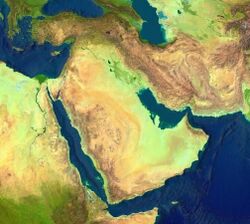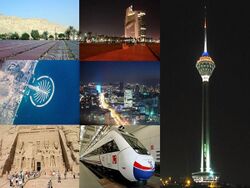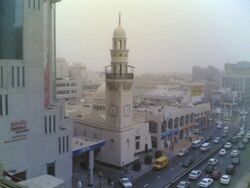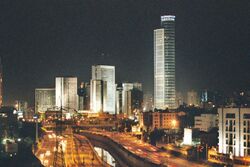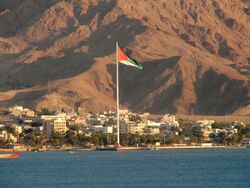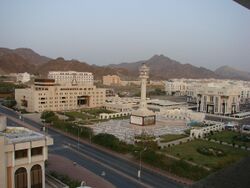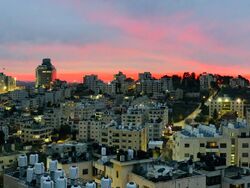Place:Economy of the Middle East
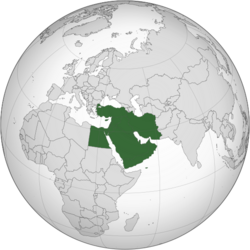 | |
| Statistics | |
|---|---|
| Population | 371 million[1][2] |
| GDP | |
GDP growth | 3.2% (2023 est.)[5] |
GDP per capita | |
| Unemployment | |
| Public finances | |
| 35% of GDP (2023 est.)[10] | |
| Most numbers are from the International Monetary Fund. IMF Middle East Datasets All values, unless otherwise stated, are in US dollars. | |
The economy of the Middle East is very diverse, with national economies ranging from hydrocarbon-exporting rentiers to centralized socialist economies and free-market economies. The region is best known for oil production and export, which significantly impacts the entire region through the wealth it generates and through labor utilization. In recent years, many of the countries in the region have undertaken efforts to diversify their economies.
Overview
An International Monetary Fund (IMF) analysis of growth determinants indicates that greater integration with international markets could provide a substantial boost to income and gross domestic product (GDP) growth.[11]
| MENA region | 2009 | 2011 | 2012 |
|---|---|---|---|
| Real GDP growth | 2.8 | 3.6 | 4.5 |
| Real GDP growth (PPP) | 2.7 | 3.5 | 4.5 |
| Exports (change %) | −9.5 | 2.6 | 5.2 |
| Imports (change %) | 1.2 | 4.9 | 6.6 |
| CA balance (% of GDP) | −0.1 | 1.5 | 0.9 |
| Country | GDP Per Capita (PPP) (Thousands of US$) 2024[13] |
GDP (PPP) (Billions of US$) 2022[14] |
GDP Nominal (Billions of US$) 2022 |
|---|---|---|---|
| $62.75 | $78.76 | $41.46 | |
| $17.79 | $1,493 | $438.348 | |
| $20.69 | $1,573 | $367 | |
| $12.05 | $413 | $250.070 | |
| $56.68 | $478 | $520 | |
| $13.44 | $102.158 | $42.609 | |
| $53.76 | $303 | $118.271 | |
| $11.79 (2022; latest) | $78.910 | $19.008 | |
| $40.02 | $165.947 | $110.127 | |
| $6.82 | $ N/A | N/A | |
| $118.15 | $315.299 | $236.257 | |
| $71.37 | $1,870 | $876.150 | |
| $6.37 (2010; latest) | $102.5 | $77.460 | |
| $43.62 | $3,210 | $692 | |
| $92.95 | $779 | $501.354 | |
| $2.1 | $65 | $28.134 |
According to Bayt.com's Middle East Consumer Confidence Index, March 2015:[needs update] While close to a quarter (24%) of respondents indicated that their country's economy had improved over the previous 6 months, over one third (35%) thought that it had gotten worse. Those in Syria were the most negative about their country's economy: 83% of them thought it has receded as compared to 6 months prior. 38% of respondents expected the economy in their country to improve in the following 6 months, while a quarter expected it to get worse. Overall, only 7% believed that business conditions of that time were 'very good'; 24% thought business conditions were 'good'. Half of respondents expected business conditions in their country to have improved in the following year. Respondents from Syria tended to be more pessimistic about future business conditions: about half of them (49%) thought they would become worse.[15]
By country and territory
Bahrain
In 2018 Bahrain has a per capita GDP of US$50,700.[16] Bahrain has the Persian Gulf's first "post-oil" economy.[17] Since the late 20th century, Bahrain has heavily invested in the banking and tourism sectors.[18] The country's capital, Manama, is home to many large financial institutions. Bahrain has a high Human Development Index (ranked 48th in the world) and was recognised by the World Bank as a high income economy. Bahrain has expanded its industrial capacity to include aluminum production and signed a Free Trade Agreement with the United States in an effort to expand its export base. Bahrain has also positioned itself as a strong player in Islamic banking in an effort to expand beyond resource exports and into a greater role in the international service industry.[19]
Egypt

Egypt derives a great deal of its foreign exchange from tourism. Consequently, most of its labor force is devoted to the service sector.[20] Agriculture is also a large part of the Egyptian economy. The Nile River provides Egypt with some of the most fertile land in the Middle East. It produces food for consumption and export as well as cotton for domestic and foreign textile production. Egypt's other great resource is the Suez Canal. Roughly 7.5% of global sea trade transits the canal providing Egypt revenues in excess of $3 billion annually.[21] Egypt's industrial base dates to the 1960s, when the nation undertook import substitution industrialization policies.[22] The inefficiencies of the state-run program have led the government to begin a privatization program and as a result Egypt enjoyed substantial GDP growth in the first decade of the 21st century.[20] It has also taken advantage of Qualifying Industrial Zone to expand trade relations with the United States. Despite these developments Egypt remains an underdeveloped country with a per capita GDP of $5,500.[20] The Egyptian Commodities Exchange is the first electronic exchange in the MENA (Middle East and North Africa) region, abolishing a monopoly and allowing small farmers to trade at reasonable market prices.[23][24]
Iran
Iran has one of the largest economies in the Middle East. It is the world's 18th largest by PPP. Iran's major industries are largely state-owned. The nature of the Iranian state-owned enterprises has led to a degree of inefficiency. Iran ranks 69th out of 139 in Global Competitiveness Report.[25] Iran has been able to subsidize inefficient industry with its large oil revenues, and maintain respectable growth rates. The nature of the state-driven economy has led to significant brain drain in recent years as educated Iranians seek opportunities abroad. Consequently, Iran has begun a privatization effort in order to stimulate trade in accordance with its ongoing five-year plan, and has also undertaken an ambitious economic reform plan.
The chief advantage that Iran's capital market has in comparison with other regional markets is that there are 40 industries directly involved in it. Industries, including the automotive, telecommunications, agriculture, petrochemical, mining, steel, iron, copper, banking and insurance, financial mediation and others trade shares at the Tehran Stock Exchange, which makes Iran unique in the Middle East.[citation needed] Iran has a high potential to become one of the world's largest economies in the 21st century.[26]
In 2018 Gottfried Leibbrandt, chief executive of SWIFT, said in Belgium that some banks in Iran would be disconnected from this financial messaging service.[27] On 13 November 2018 International Monetary Fund released a report and predicted that Iran's inflation rate would go as high as 40% by the end the year.[28]
According to the Statistical Center of Iran, Iran's annual inflation rate stood at 42.4% during the month December 21, 2021 to January 20, 2022. Prices continued to rise for housing & utilities (28.5% vs 27.9 in January); transport (36.1% vs 35.3%); communication (3.8% vs 2.3%); and tobacco (35.0% vs 33.3%).[29]
Iraq
Nearly 30 years of fighting, against Iran in the 1980s and the United States since 1991, has had a detrimental impact on Iraqi economic growth. Oil production remains Iraq's chief economic activity. The lack of development in other sectors has resulted in 18–30% unemployment and a depressed per capita GDP of $4,632.[30] Reconstruction aid has helped to bolster the nation's infrastructure.
Israel
Israel's national leadership created a socialist economy when Israel was established in 1948. The purpose of this approach was to establish economic self-sufficiency, particularly agriculturally, in the face of hostile neighbors and to provide jobs for a population rapidly expanding through immigration. The socialist nature of the economy created a great deal of inefficiency which the government was able to offset through foreign aid, first in the form of West German Holocaust reparations then through direct aid, primarily from Western nations.
Following the Yom Kippur War Israeli defense spending rose dramatically, exposing the weaknesses of the state-run economy.[31] The result was rampant inflation that led Israel to recall the pound in 1980 and issue the sheqel. This move did not sufficiently curb inflation and consequently the sheqel was recalled in 1985 in favor for the Israeli new sheqel, a move implemented together with a comprehensive economic stabilization program which stemmed inflation and set the stage for high growth in the 1990s. Israel had also undertaken a privatization effort beginning in the late 1970s.
The economy received a boost in the early 1990s with the arrival of several hundred thousand immigrants from the former Soviet Union.[32] As a significant number of the immigrants were highly educated, Israel accelerated its privatization to encourage the high-skilled workers to stay. The new labor also attracted foreign direct investment. Israel's growth over the past decade[which?] has been commensurate with Western developed nations as is its per capita GDP (PPP), which is about $35,000/year – the third highest (behind Bahrain and the UAE) of the Middle Eastern countries not dependent on natural resources. It also has the highest economic complexity index of all the countries in the Middle East. Israel is described as "very highly developed" on the United Nations 's Human Development Index, ranking 16th among 187 world nations and highest in the Middle East in 2012.
In September 2010, Israel joined the OECD (Organisation for Economic Co-operation and Development), which praised Israel's scientific and technological progress and described it as having "produced outstanding outcomes on a world scale."[33] Much of the growth in the country's economy over the past couple of decades is attributable to the software, biomedical, electronics, telecommunications and other high-technology sectors as the percentage of Israelis engaged in scientific and technological inquiry, and the amount spent on research and development (R&D) in relation to gross domestic product (GDP), is among the highest in the world.[34] The high-tech industry contributes to about 43 percent of Israeli exports, but only employs 8.3 percent of the industry's workers.[35]
Jordan
This section's factual accuracy is disputed. (May 2017) (Learn how and when to remove this template message) |
Jordan operates a rentier economy based largely on foreign aid, investment, and remittances. Jordan heavily depends on its highly skilled workforce in the oil-rich Persian Gulf to send back money to help support thousands of Jordanian families. Consequently, its economic fortunes are tied to events in the international community. Although the standard of living in Jordan is significantly higher than other countries with similar incomes, having among the best education and healthcare systems in the Middle East,[36] many Jordanians opt to work abroad because of soaring costs of living and high unemployment in their native country. Jordan is dependent on those remittances which have accounted for nearly 20% of GDP since 1975.[37] Jordan's dependence has had detrimental consequences. Following Iraq's 1990 invasion of Kuwait hundreds of thousands of Palestinians were expelled from other Arab nations. For Jordan this resulted in the significant loss of remittance revenue.[38]
Although the 2003 Iraq War first brought detrimental consequences to Jordan's economy, it gave Jordan a huge boost in trade and investment with wealthy Iraqis re-settling in Jordan; Amman become a transit point for business and trade bound to Iraq. Jordan consequently became known as the "Gateway to Iraq" and later the "Gateway to the Middle East". Jordan's pro-business and pro-Western government has created incentives and free trade zones to spur further economic growth.
Jordan's private sector growth has been given higher priority in recent years. Manufactured exports have increased by taking advantage of Qualifying Industrial Zones, led largely through the growth of a textile industry.[39] Jordan's shift to a free-market economy has brought unprecedented amounts of investments. Jordan has one of the freest economies in the Middle East due to several key economic reforms in the past few years.[when?][citation needed] Tourism, ICT, trade, and future oil shale and uranium exports will form the backbone of Jordan's economy.[according to whom?]
Kuwait
The Kuwaiti currency is the highest-valued currency unit in the world.[40] In 2010 Kuwait had the second-most-free economy in the Middle East according to the Index of Economic Freedom.[41][needs update] 57% of Kuwait's GDP comes from non-oil industry (mostly business services, manufacturing, retail trade, financial institutions, construction, transport and real estate).[42] Petroleum accounts for 43% of GDP, 87% of export revenues, and 75% of government income.[42][43] Kuwait also exports chemical fertilizers.[44] The per capita GDP is $51,912.[45] As part of a diversification plan the Kuwaiti government has invested its revenues and maintains a sizable sovereign wealth fund. In 2008 these investments accounted for more than half of Kuwait's GDP.[46] 60% of Kuwait's work force are non-Kuwaitis.[47]
Lebanon
The GDP per capita of Lebanon was $16,000 in 2012 US dollars. At that time Lebanon had the highest in GDP per capita after 6 Gulf Cooperation Council (GCC) state members and Israel, as per the CIA World Fact Book. However, the economy of Lebanon had been severely inhibited by internal sectarian conflict and conflict with Israel. The government incurred significant debt attempting to rebuild the national infrastructure following the Lebanese Civil War. Through foreign assistance the nation had made strides to rebuild, but remained largely underdeveloped. Its trade deficit was nearly $8 billion and its external debt $31.6 billion.[when?] Lebanon's economy is being rebuilt, especially by the remarkable growth of its industry (including cement) and services sector which presents more than 70% of the country's economy. Beirut is regaining its place as a financial center of the Middle East with foreign investment returning in all sectors, encouraged by steady growth.[48]
Oman
Oman has several different industries including crude oil production and refining, natural and liquefied natural gas (LNG) production, construction, cement, copper, steel, chemicals and optic fiber. Oman also has substantial trade and budget surpluses. 55% of Oman's government revenues come from non-oil industries. Petroleum accounts for 64% of total export earnings, 45% of government revenues and 50% of GDP.[46] By 2020 Oman hopes to reduce oil revenue to just 9% of its income.[49] Along with that plan the country hopes to move away from rentier economics, employ its citizens in the labor market and reduce reliance on expatriate labor.[49] To take its first steps in economic independence it has signed a Free Trade Agreement with the United States and is seeking to do the same with the European Union, China , and Japan .[49] It is currently maneuvering itself into the re-export and heavy-manufacturing markets.
Palestine
Since 1970s, Palestine had a favorable growth rate.[50] The growth was higher than even Arab countries.[51] For 30 years, Israel opened its market for Palestinian labor force.[52] Many joint industrial parks were developed in borders of Israel and Palestine.[53] Airports used to be in Gaza and Jerusalem which further supported economic development.[54] At that time, even in disputed places of Jerusalem, many Palestinian companies had headquarters in the city.
Production has dropped since the beginning of the Second Intifada in 2000. The Gaza Strip has been blockaded by Israel and Egypt since June 2007 after Hamas took control of Gaza in the course of a conflict with rival Palestinian group Fatah. In May 2010, the UN Office for the Coordination of Humanitarian Affairs stated that the formal economy in Gaza has collapsed since the imposition of the blockade.[55] The West Bank has fared significantly better since the split in the Palestinian power structure, and Fatah took power in the West Bank. The official GDP per capita of the West Bank was more than double that of the Gaza Strip in 2015.[56] Palestine remains almost entirely dependent on foreign aid. Collectively, Palestine had a per capita GDP of $4,300 in 2014.[57]
Since 2010, Palestinian reform have seen economic boom in West Bank and quite in Gaza Strip. The recent years saw a large-scale development of shopping malls, luxury hotels, technology parks and industrial zones.[58] Though 2000 intifada had destroyed Gaza and Jerusalem economy.[59] But it fueled the growth of Ramallah into a financial and technical hub of the country.[60]
Massive oil and gas reserves have been founded in Palestinian territories.[61] In 2000, natural gas reserves founded on the coast of Gaza Strip.[62] Palestinian leader Yasser Arafat lauded these reserves as a gift from God.[63] This oil and gas reserves can fuel economic growth of Palestine.[64]
Qatar
Qatar currently enjoys the region's highest per capita GDP at $128,000.[65] It has derived its wealth from exploiting its natural gas reserves. With the revenues from its hydrocarbon industries Qatar has established a rentier economy. Qatar has also established the largest per capita sovereign wealth fund in the world. With a population under one million, the government has not found it necessary to diversify its economy.[citation needed]
Saudi Arabia

The economy of Saudi Arabia is one of the top twenty economies in the world, and the largest economy in the Arab world and the Middle East.[66] Saudi Arabia is part of the G20 group of countries.[67]
With a total worth of United States dollar 34.4 trillion, Saudi Arabia has the second most valuable natural resources in the world.[68] The country has the second-largest proven petroleum reserves,[69] and is the largest exporter of petroleum in the world.[70] It also has the fifth-largest proven natural gas reserves[71] and is considered an "Energy Superpower".
The economy of Saudi Arabia is heavily dependent on oil,[72] and is a member of OPEC. In 2016 the Saudi Government launched its Saudi Vision 2030 to reduce the country's dependency on oil and diversify its economic resources. In the first quarter of 2019, Saudi Arabia's budget has accomplished its first surplus since 2014. This surplus that is accounted for $10.40 billion has been achieved due to the increase of the oil and non-oil revenues.[73]
Syria
Stemming from a 1960s nationalization effort most of the Syrian economy is run by the government.[74] However, an inefficient public sector, significant domestic subsidies, and considerable intervention investment in Lebanon have led to significant problems of inflation and external debt.[75] Consequently, the Syrian government has undertaken modest privatization reform in preparation for the opening of the Damascus Stock Exchange in 2009.[76] Modest oil production and an agriculture sector lead Syria's production while most of its employment is in the service sector. Its per capita GDP stands at $4,900.[76][needs update]
Turkey
Turkey is the largest economy in the Middle East followed by Saudi Arabia, Iran and the UAE. Turkey has the world's 15th largest GDP-PPP[77] and 15th largest Nominal GDP.[78] The country is a founding member of the OECD (1961) and the G-20 major economies (1999). Turkey has been part of the EU Customs Union since 31 December 1995.
Turkey is often classified as a newly industrialized country by economists and political scientists;[79][80][81] while Merrill Lynch, the World Bank and The Economist magazine describe Turkey as an emerging market economy.[82][83][84]
Turkey is restructuring its economy in an attempt to gain full European Union membership. It began this policy in the early 1970s, abandoning its previous import substitution industrialization policy.[85] As privatization has taken hold in Turkey it has brought with it significant foreign direct investment. Additionally, the Baku–Tbilisi–Ceyhan pipeline has brought revenue to Turkey and enabled it to share in some of the regional hydrocarbon wealth. Turkey's economy is currently led by its automobile, agricultural, construction and textile sectors. It has a per capita GDP of $11,200, supplemented by some 1.2 million Turks working abroad.[86]
Turkey's economy has been considered a regional success story in the past. As per the Turkish Statistical Institute, a government agency committed to producing official statistical data on the country, the country's inflation rate increased by 14.03% in November 2020. The statistics showed a 1.5 points increase as per the expected level; a 15-month high. As of December 2020 stats, the figures show a 2.3% increase in monthly consumer prices and a significant price rise in basic necessities such as food, beverages, and transportation. Meanwhile, the fall of the Turkish lira has been reported for years. Since the start of 2020, it has lost more than 30% of its value as compared to the US dollar and 30% against the euro.[87]
United Arab Emirates
The economy of the United Arab Emirates (UAE) is the second largest in the Arab world (after Saudi Arabia), with a gross domestic product (GDP) of $377 billion (AED1.38 trillion) in 2012. The United Arab Emirates has been successfully diversifying the economy. 71% of UAE's total GDP comes from non-oil sectors.[88] Oil accounts for only 2% of Dubai's GDP.[89] The UAE is also making an effort to attract foreign direct investment by offering 100% foreign ownership and no taxes.[90] Tourism is one of the main sources of revenue in the UAE.
A rating agency, Moody's Investors Service revised its rating of eight UAE banks from stable to negative amidst the coronavirus outbreak. The eight banks included Emirates NBD, Abu Dhabi Commercial Bank, Dubai Islamic Bank, Mashreq Bank, HSBC Bank Middle East, Abu Dhabi Islamic Bank, National Bank of Ras al-Khaimah and National Bank of Fujairah.[91]
The UAE cabinet introduced a UBO law in early 2021 after global pressure for financial transparency in the corporate sector increased. The pressure was sourced from the investigations carried out by the International Consortium of Investigative Journalists like the 2016 Panama Papers pushing to pass the Ultimate Beneficial Ownership or UBO registries. Following Dubai's increasing role in being a safe haven for the investment of illicit funds and provision of financial secrecy to people behind it – as disclosed under other ICIJ probes such as FinCEN Files and Luanda Leaks – has led to the introduction of the beneficial ownership law in the UAE. According to ICIJ, companies not abiding by the law and failing to report beneficial ownership information will have to bear administrative penalties and fines worth approximately 100,000 UAE dirhams, starting July 1, 2021. However, considering the lack of a centralized register to track all financial activities, loopholes, and exemptions in the UBO law itself, advocates believe that it isn't enough as a standalone to control money laundering in UAE.[92]
Yemen
Yemen has suffered from chronic economic mismanagement. With 85% unemployment, the nation relies heavily on expatriate remittances.[93] The reliance on foreign labor markets proved disastrous following the 1991 Persian Gulf War when Saudi Arabia and Kuwait expelled Yemeni workers and curtailed aid to the country in response to its support of Iraq.[39] Most of Yemen's GDP comes from its limited oil production. The bulk of its labor is involved in agriculture where its primary cash crop is khat. On 3 November 2018 a British MP from Labor Party blamed Iran backed rebels in Yemen for the disastrous humanitarian crisis in that country. Graham Jones, chairman of the Commons Committees on Arms Exports Controls (CAEC) has questioned the British Government ‘s arm sales.[94]
Job index
The Middle East Job Index Survey conducted by Bayt.com in February 2015 stated that: Overall, the Job Index had decreased by one point since the last wave of August 2014. In the UAE, the Job Index had decreased by four points since August 2014.[further explanation needed]
Three-fifths of working respondents in the MENA stated that they would be hiring in the following 3 months. Plans to hire in those 3 months were higher in the Gulf Cooperation Council (GCC) countries (Saudi Arabia, United Arab Emirates, Bahrain, Kuwait, Oman and Qatar), with 37% 'definitely' hiring, compared to 30% in the Levant and 29% in North Africa.
7 in 10 working respondents stated that they would be hiring in a year's time. The plans for hiring in a year's time showed more positive results amongst the GCC countries, with 37% 'definitely' hiring after 12 months, compared to 30% in Levant and North Africa. 65% of those who planned to hire in the following 3 months indicated that they would be hiring for up to 10 positions. Over three-fifths (64%) of working respondents stated that their companies have hired new employees in the previous 6 months.
The trend continued from past waves with most employers planning to hire people for junior or mid-level executive positions. Accountants (17%) and sales managers (16%) were the top job roles companies expected to be hiring in the 3 months following the survey. Post-graduate degrees in business management were the most sought-after qualification in the MENA. This was followed by degrees in engineering and commerce. Good communication skills in Arabic and English were the top attribute companies sought in a respondent, followed by 'being a team player'. In terms of experience, managerial skills were the most sought, followed by experience in sales and marketing, and computer skills.
Overall, two-fifths believed that their country of residence was more attractive as a job market in comparison to other MENA countries. When compared to the Levant region (16%) and North Africa (19%), significantly more respondents in the GCC (40%) thought that their country of residence is a more attractive job market. Almost half of working respondents rated their own industry as being more attractive as a potential employer in comparison to other industries. Overall, banking and finance were first in terms of the industry which respondents considered to be attracting/retaining talent in their country of residence.[95]
Economic reform
Following the oil boom of the 1970s, Middle Eastern economies have implemented several reform policies aimed at sustaining economic growth and increasing participation at the macroeconomic level. The implementation of these economic reforms became more urgent in the region as oil price volatility threatened the economic stability of major oil-exporting countries. While each country follows its own economic agenda, many face similar challenges and target issues which affect the region as a whole. The policies are especially concerned with attracting foreign investment in an integrated global economy.[96]
Countries within the Middle East have also begun implementing policies to promote integration between Middle Eastern countries. These are hoped to help the region reach its full economic potential and to sustain the stability of countries that have accomplished higher rates of growth and development.[97]
Background
Following the OPEC embargo of October 1973, the market price of oil per barrel rose from $3 to $12 per barrel in reaction to the 5% production cut and reduction of supply by OPEC countries. The OPEC embargo was directed at the United States and other countries (the Netherlands, Portugal and South Africa), in retaliation for their financial aid and support of Israel during the Yom-Kippur War.[98][better source needed] The embargo was also prompted by the decision of President Richard Nixon to take the United States off the gold standard, hurting oil-producing countries which collected revenue in US dollars. While the OPEC embargo exacerbated the deep recession and inflation in the United States, the economies of the Middle East witnessed rapid expansion and growth in GDP as well as an increase in the Middle East's share of global world trade from 3.6% in 1972 to 8% in 1979.[99] In addition to experiencing economic growth, the Middle East also made improvements in development indicators such as infant mortality and life expectancy, and a decrease in unemployment across most sectors.
Following the oil boom and the OPEC embargo of the 1970s, the Middle East became a heavily integrated region in terms of economic growth and employment. The increase in the export of oil by the major oil-exporting countries in the Middle East led to a mass influx of foreign workers from Arab and Asian countries. Towards the end of the 1980s the growth began to stop as the price of oil fell in an increasingly competitive global market. As a result, countries such as Morocco, Tunisia and Jordan began to implement economic reforms during the mid-1980s. Soon after, most countries within the region had implemented some form of economic stabilisation policy. During the 1990s the Gulf Cooperation Council (GCC) countries (Saudi Arabia, United Arab Emirates, Bahrain, Kuwait, Oman and Qatar) were becoming increasingly vulnerable to oil-price volatility.[100]
Religious issues
For many Middle Eastern countries religion is heavily integrated into economic policy and has proved to be a major obstacle to effective economic reform. Religious instability in the region deters foreign investment and global economic integration. Political transparency has also proven to be a deterrence to economic development. Since the quality of institutions and governance are important factors in stimulating growth, economic reform in the Middle East may not be complete if religious reform is not suggested or implemented simultaneously. The political instability and continuous regional conflict (such as the Palestine–Israel conflict) prevents the region from achieving its highest potential as it consistently faces humanitarian crises that affect development indicators such as life expectancy and infant mortality rate.
Integration into the global economy
Another common issue that the region has addressed in economic and policy reforms is the integration of the Middle East into the global economy. Reports of economic reform in the Middle East in the early 2000s called for massive reforms to improve the Middle East's global financial integration as it stood below most developed regions. Such reports also called for a reform of the trade sector and agreements that had prevented most trade (other than oil exports). Noting trade openness as "a significant contributor to higher productivity per capita income growth",[101] several countries in the Middle East have accomplished the common goal of trade reform and openness.
Reforms in new age of the Middle East
Subsidy Reform
History of price subsidies in the Middle East
A common issue within Middle Eastern economies is the use of subsidies, of which energy subsidies account for the most. These price subsidies were first introduced over a thirty-year period beginning in 1940, and many of them began simply as price stabilisers. However over time they transformed into price subsidies. While meant to be implemented as a "social protection" or welfare tool, the subsidies were not adequately targeted nor were they cost-effective, defeating their primary purpose. They were not reaching the people who needed more government assistance, but instead benefitted a large portion of richer citizens. Subsidies had been embraced, often being the only social protection program in place, and several Middle Eastern nations came to see them as natural rights of citizens. This made their removal difficult, and pressure for their removal during the 1990s was lower because they accounted for a relatively small portion of GDP.[102]
Pressure for reform
Following the 1990s, the pressure to reform price subsidies began to build as the price of oil steadily rose in the 2000s. It became apparent that price subsidies were preventing governing bodies from implementing needed social programs.[102] Price subsidy reform became more tangible following the 2008–2009 global financial crisis, under which the prices of commodities rose, invariably raising the subsidies on these commodities.
Reform
Beginning in 2010, six countries in the Middle East (Iran, Yemen, Jordan, Tunisia, Morocco and Egypt) made significant reforms to their price subsidies system. Iran was the first country in the region to do so, and began by implementing major price increases on all fuel products, electricity, water and transport. This was offset by the implementation of monthly cash transfers of 445,000 rials per person. In terms of non-subsidised commodities, the prices of such goods also rose, with increases in price averaging around 30% and peaking at 100%.[102] The cash transfers provided to citizens were found to be excessive and were disproportionately benefiting the richer citizens of the country. Due to the adverse effects of the subsidy reform, some portions of the reform were repealed in March 2012 under the newly amended Targeted Subsidies Reform Act.
Another country in the region that implemented subsidy reforms was the Republic of Yemen, which did so with the help of the International Monetary Fund and the World Bank in 2005–2010. During this period, prices periodically increased several times. In 2011 and 2012, increases in the price of gasoline, diesel and kerosene continued, drawing little public attention. However, the decision to remove all subsidies in 2014 increased prices by almost 90% for some products, drew public outcry and led to the reverse of some of these reforms within the year.
Other countries have taken different approaches, varying from extreme to gradual reforms. The effectiveness is dependent on many different factors such as the political climate during the time of the reform or whether or not the public receives precautionary warnings and advice in regards to coping with the removal of subsidies from goods and services. The reduction of subsidies in the Middle East is an ongoing challenge, but has developed significantly though there are often setbacks as they remain susceptible to changes in regime, political conditions, and socioeconomic factors.
Economic diversification
Middle Eastern countries have increasingly attempted to diversify their economies, particularly the oil-exporting countries. The countries of the Gulf Cooperation Council have addressed this issue and have taken a strong stance in the implementation of reforms. In order to decrease resource dependency within the Gulf states, reforms and policy proposals for the future have been implemented and follow a plan of economic development, signalling the move from natural resources to a globally-integrated diversified economy hoped to attract foreign investment. Examples of such plans to diversify include Saudi Arabia's Vision 2030 and the United Arab Emirates' Economic Vision 2030, each of which outline the country's goals to reach the desired level of economic growth and development by 2030.
Saudi Arabia Vision 2030
Saudi Arabia's economic vision for the year 2030 outlines various goals that the kingdom hopes to achieve.[103] One is the expansion of small and medium-sized enterprises (SME) to account for 35% of GDP, nearly double its current[when?] 20%. The plan outlines an allocation of 20% of funding to SMEs.[further explanation needed] The plan also mentions continued privatisation of "state-owned assets".
Abu Dhabi Economic Vision 2030
Abu Dhabi (capital of the United Arab Emirates) has set goals for achieving an increasingly global and diversified economy by 2030, funded with the city's acquired oil wealth.[104] Focusing on GDP by sector, the plan emphasises the link between economic diversification and economic sustainability. The Emirate is also concerned in developing the private sector within the city and states that at publication in 2008, that the ratio of small privately owned businesses to large businesses was on-par with developed countries.
Value added tax in the GCC
As of January 2016, Saudi Arabia and the United Arab Emirates announced the plan to implement value-added tax (VAT) in the GCC as a response to the decrease in oil prices beginning in 2014. VAT is expected to be effective in the GCC in January 2018, however some countries may implement this tax later into the year. The UAE, KSA and Bahrain have now implemented VAT leaving three GCC countries (Oman, Kuwait, and Qatar) to still implement VAT.
Implications
Though each member of the GCC will establish a separate national implementation of VAT, the implications of VAT on the economy are similar. First, the requirements for businesses operating under VAT appear universal across the region: all businesses that exceed the VAT threshold must register, filing periodic VAT returns with tax officials, and record keeping of all business transactions.[105] Similar considerations are to be taken by businesses and governmental bodies. VAT may not apply to all financial services (such as services involving Islamic banking or insurance). Considerations of VAT on the oil and gas industry must also be made. The retail sector may also be adversely affected; retailers must be aware of the correct way to classify sales and implement retail loyalty schemes.
History
Around 1800
Textile production was the most-important industry, complemented by food-processing, furniture and some specialized industries. Industrial production was mostly concentrated in the cities. With exception of Istanbul, the cities themselves were all situated next to a substantial area of cultivatable land with soil quality. Most industries, with fixed price and guild systems, were not conducive to innovation, even if a certain quality of craftsmanship was preserved. Another important urban function was to organize caravan trade.[106]
Early nineteenth century
During the early nineteenth century, the situation in the Middle East changed dramatically because of three development paths: mild reforms and problematic openness in the Ottoman imperial core, forced development in Egypt and direct colonization in central Asia and Algeria.[107]
When comparing living standards, the Middle East did better than the Western industrialized countries in the mid-19th century. With the income levels and the onset of huge structural changes around 1900, an economic setback determines consumption behaviour and led to permanent changes in the nutritional status of the Middle Eastern populations. Therefore, the Western industrialized countries overtook the Middle Eastern living standards around 1900.[108]
20th century
Following a period of deindustrialization, political movements in the Middle East demanded a political renaissance and leaders saw the need for reindustrialization.[109]
See also
- Middle East economic integration
- Start-up Nation
- Economy of Asia
- Economy of Africa
- Middle East and globalization
- List of Asian stock exchanges
- Middle East Economic Association
References
- ↑ ""World Population prospects – Population division"". United Nations Department of Economic and Social Affairs, Population Division. https://population.un.org/wpp/.
- ↑ ""Overall total population" – World Population Prospects: The 2019 Revision" (xslx). United Nations Department of Economic and Social Affairs, Population Division. https://population.un.org/wpp/Download/Files/1_Indicators%20(Standard)/EXCEL_FILES/1_Population/WPP2019_POP_F01_1_TOTAL_POPULATION_BOTH_SEXES.xlsx.
- ↑ "GDP (Nominal), current prices". International Monetary Fund. https://www.imf.org/external/datamapper/NGDPD@WEO/OEMDC/ADVEC/WEOWORLD. Retrieved 5 November 2022.
- ↑ "GDP (PPP), current prices". International Monetary Fund. https://www.imf.org/external/datamapper/PPPGDP@WEO/OEMDC/ADVEC/WEOWORLD/AFQ. Retrieved 5 November 2022.
- ↑ International Monetary Fund (2022). "Real GDP growth". IMF Data Mapper. International Monetary Fund. https://www.imf.org/external/datamapper/NGDP_RPCH@WEO/OEMDC/ADVEC/WEOWORLD.
- ↑ International Monetary Fund (2022). "Nominal GDP per capita". IMF Data Mapper. International Monetary Fund. https://www.imf.org/external/datamapper/NGDPDPC@WEO/OEMDC/ADVEC/WEOWORLD.
- ↑ International Monetary Fund (2022). "GDP PPP per capita". IMF Data Mapper. International Monetary Fund. https://www.imf.org/external/datamapper/PPPPC@WEO/OEMDC/ADVEC/WEOWORLD.
- ↑ International Monetary Fund (2022). "Inflation rate, average consumer prices". IMF Data Mapper. International Monetary Fund. https://www.imf.org/external/datamapper/PCPIPCH@WEO/OEMDC/ADVEC/WEOWORLD.
- ↑ "Unemployment, total (% of total labor force)". https://data.worldbank.org/indicator/SL.UEM.TOTL.ZS?view=map.
- ↑ International Monetary Fund (2022). "General government gross debt". IMF Data Mapper. International Monetary Fund. https://www.imf.org/external/datamapper/GGXWDG_NGDP@WEO/APQ.
- ↑ "Archived copy". http://www.imf.org/external/pubs/ft/reo/2010/mcd/eng/10/mreo1024.pdf.
- ↑ "Iran's economic growth to hit 2.2% in 2010: World Bank". http://www.payvand.com/news/10/jan/1220.html.
- ↑ "IMF Data Mapper". https://www.imf.org/external/datamapper/profile.
- ↑ "CIA - The World Factbook GDP Country Comparison (PPP)". https://www.cia.gov/library/publications/the-world-factbook/rankorder/2001rank.html.
- ↑ Bayt.com Middle East Consumer Confidence Index-March 2015 , Bayt.com. Retrieved 29 June 2015
- ↑ "CIA World Factbook - Bahrain's Economy". https://www.cia.gov/the-world-factbook/countries/bahrain/.
- ↑ "Bahrain: Reform-Promise and Reality". J.E. Peterson. p. 157. http://www.jepeterson.net/sitebuildercontent/sitebuilderfiles/Peterson_Bahrain_Reforms.pdf.
- ↑ "Bahrain's economy praised for diversity and sustainability". Bahrain Economic Development Board. http://www.bahrainedb.com/EDBInBahrain.aspx?id=2134.
- ↑ Marcus Noland and Howard Pack, Arab Economies in a Changing World (Washington D.C.: Peterson Institute for International Economics, 2007), 119.
- ↑ 20.0 20.1 20.2 "CIA World Factbook - Egypt's Economy". https://www.cia.gov/the-world-factbook/countries/egypt/.
- ↑ "BBC News Suez Canal Fact Sheet". 21 July 2006. http://news.bbc.co.uk/2/hi/middle_east/5195068.stm.
- ↑ Alan Richards and John Waterbury, A Political Economy of the Middle East (Boulder, CO: Westview Press, 2008), 31.
- ↑ "Global consortium to inject $50m in Egypt commodity exchange". MUBASHER. 26 November 2015. http://english.mubasher.info/news/2848324/Global-consortium-to-inject-50m-in-Egypt-commodity-exchange#.Vlm5qiJtFzg.facebook.
- ↑ "Egypt signs protocol to establish commodities exchanges". The Cairo Post. 26 November 2015. http://thecairopost.youm7.com/news/179289/news/egypt-signs-protocol-to-establish-commodities-exchanges#prettyPhoto.
- ↑ World Economic Forum: Iran ranks 69th out of 139 in global competitiveness Retrieved September 18, 2010
- ↑ "The N-11: More Than an Acronym" Goldman Sachs study of N-11 nations, Global Economics Paper No: 153, March 28, 2007
- ↑ "SWIFT system to disconnect some Iranian banks this weekend". 9 November 2018. http://www.arabnews.com/node/1402006/business-economy.
- ↑ "Iran's Inflation Rate Will Soar To Over 40 Percent By Year-End, IMF Says". https://en.radiofarda.com/a/irans-inflation-rate-will-soar-over-40-percent-year-end-imf-says/29599539.html.
- ↑ "Latest Report Says Iran's Annual Inflation Hovers Above 40 Percent" (in en). https://www.iranintl.com/en/202201229870.
- ↑ "Iraq - The World Factbook". https://www.cia.gov/the-world-factbook/countries/iraq/#economy.
- ↑ Richards and Waterbury, 204-205.
- ↑ "Immigration from the former Soviet Union". https://www.jewishvirtuallibrary.org/jsource/Immigration/FSU.html.
- ↑ OECD's announcement.
- ↑ Ministry of Industry, Trade & Labor - Foreign Trade Administration
- ↑ "Israel Intent on Inducing Tech's Next Wave - Jewish Exponent". http://jewishexponent.com/2018/03/21/israel-intent-on-inducing-techs-next-wave/.
- ↑ "Jordan's healthcare system rated as the top in the region and among the top 5 in the world". World Bank. 5 June 2017. http://data.worldbank.org/country/jordan.
- ↑ Noland and Pack, 121.
- ↑ Noland and Pack, 169.
- ↑ 39.0 39.1 Richards and Waterbury, 68.
- ↑ "10 Most Valuable Currencies in the World". http://www.siliconindia.com/finance/news/10-Most-Valuable-Currencies-in-the-World-nid-109953.html.
- ↑ Alt, Robert. "Index of Economic Freedom". Heritage.org. http://www.heritage.org/research/features/index/country.cfm?id=Kuwait.
- ↑ 42.0 42.1 "Kuwait Economic Report". http://www.capstandards.com/CSR_KuwaitEconomicReport_Feb2011.pdf.
- ↑ "OMCAP - Overseas Manpower Company of Andhra Pradesh". http://www.omc.ap.gov.in/kuwait.aspx.
- ↑ "The World Factbook — Central Intelligence Agency" (in en). https://www.cia.gov/library/publications/the-world-factbook/fields/2049.html#ku.
- ↑ "GDP pr. Capita current Kauwait". https://data.worldbank.org/indicator/NY.GDP.PCAP.PP.CD?locations=KW.
- ↑ 46.0 46.1 Richards and Waterbury, 203.
- ↑ "CIA World Factbook - Kuwait's Economy". https://www.cia.gov/the-world-factbook/countries/kuwait/.
- ↑ "CIA World Factbook - Lebanon's Economy". https://www.cia.gov/the-world-factbook/countries/lebanon/.
- ↑ 49.0 49.1 49.2 "CIA World Factbook - Oman's Economy". https://www.cia.gov/the-world-factbook/countries/oman/.
- ↑ "Palestinian economy and prospects for regional cooperation - UNCTAD study" (in en-US). https://www.un.org/unispal/document/auto-insert-186101/.
- ↑ "Palestinian Economy – From Dependency to Regional Cooperation?" (in en). https://www.boell.de/en/2010/03/08/palestinian-economy-asymmetrical-dependency-regional-cooperation.
- ↑ Baroud, Ramzy. "The decades-old war on Palestinian workers" (in en). https://www.aljazeera.com/opinions/2019/8/23/the-decades-old-war-on-palestinian-workers.
- ↑ "He’s in the business of peace with £14m ‘capitalist kibbutz’" (in en). https://www.thejc.com/news/israel/hes-in-the-business-of-peace-with-14m-capitalist-kibbutz-tzhrbfkd.
- ↑ Moussa, Emad (2022-07-26). "Palestine's airports: Past, present, and future dreams" (in en). https://www.newarab.com/analysis/palestines-airports-past-present-and-future-dreams.
- ↑ "Press Statement - UN Humanitarian Coordinator: Gaza Blockade Suffocating Agriculture Sector, Creating Food Insecurity". UN Office for the Coordination of Humanitarian Affairs, oPt (OCHA). 2010-05-25. http://www.ochaopt.org/documents/gaza_agriculture_25_05_2010_press_release_english.pdf.
- ↑ Palestine in Figures: 2016 Palestinian Central Bureau of Statistics, 2017.
- ↑ "CIA World Factbook - West Bank Economy". https://www.cia.gov/the-world-factbook/countries/west-bank/.
- ↑ Mittelstaedt, Juliane von (2011-04-27). "Dream of a Palestinian Tiger: Boom Times in the West Bank" (in en). Der Spiegel. ISSN 2195-1349. https://www.spiegel.de/international/world/dream-of-a-palestinian-tiger-boom-times-in-the-west-bank-a-759046.html.
- ↑ "The Atarot Exception? Business and Human Rights under Colonization" (in en). https://www.palestine-studies.org/en/node/1649529.
- ↑ Abukhater, Maher; Times, Los Angeles (2010-12-25). "Palestinian mayor presides over boom times in Ramallah" (in en-US). https://www.latimes.com/archives/la-xpm-2010-dec-25-la-fg-ramallah-qa-20101226-story.html.
- ↑ Elkhafif, Mahmoud. "Palestine’s forgotten oil and gas resources" (in en). https://www.aljazeera.com/opinions/2021/6/21/palestines-forgotten-oil-and-gas-resources.
- ↑ Reed, Stanley (2023-11-13). "Chevron Restarts Gas Production on Platform Near Gaza Strip" (in en-US). The New York Times. ISSN 0362-4331. https://www.nytimes.com/2023/11/13/world/middleeast/chevron-israel-tamar-gas.html.
- ↑ Moussa, Emad (2021-05-26). "Gaza's gas fields: How Israel shackled Palestine's economy" (in en). https://www.newarab.com/analysis/gazas-gas-fields-how-israel-shackled-palestines-economy.
- ↑ Atmos (2023-11-29). "‘This Genocide Is About Oil’" (in en). https://atmos.earth/this-genocide-is-about-oil/.
- ↑ "CIA World Factbook - Qatar's Economy". https://www.cia.gov/the-world-factbook/countries/qatar/.
- ↑ "GDP (current US$) | Data". https://data.worldbank.org/indicator/NY.GDP.MKTP.CD?most_recent_value_desc=true&year_high_desc=true.
- ↑ "Group of Twenty members". http://g20.org.tr/about-g20/g20-members/.
- ↑ Anthony, Craig. "Which 10 Countries Have the Most Natural Resources?". https://www.investopedia.com/articles/markets-economy/090516/10-countries-most-natural-resources.asp.
- ↑ "The World's Largest Oil Reserves By Country" (in en). https://www.worldatlas.com/articles/the-world-s-largest-oil-reserves-by-country.html.
- ↑ Workman, Daniel (2018-11-30). "Crude Oil Exports by Country" (in en-US). http://www.worldstopexports.com/worlds-top-oil-exports-country/.
- ↑ "World Natural Gas Reserves by Country (Trillion Cubic Feet)" (in en). https://www.indexmundi.com/energy/?product=gas&graph=reserves&display=rank.
- ↑ Department, Knowledge Management. "Kingdom of Saudi Arabia - Ministry of Commerce and Investment" (in en-us). https://mci.gov.sa/en/AboutKingdom/Pages/SaudiEconomy.aspx.
- ↑ "Saudi Arabia sees first budget surplus since 2014" (in en). 2019-04-24. http://www.arabnews.com/node/1487371/business-economy.
- ↑ Richards and Waterbury, 194.
- ↑ Richards and Waterbury, 195.
- ↑ 76.0 76.1 "CIA World Factbook - Syria's Economy". https://www.cia.gov/the-world-factbook/countries/syria/.
- ↑ The World Bank: World Economic Indicators Database. GDP (PPP) 2008. Data for the year 2008. Last revised on July 1, 2009.
- ↑ The World Bank: World Economic Indicators Database. GDP (Nominal) 2008. Data for the year 2008. Last revised on July 1, 2009.
- ↑ Mauro F. Guillén (2003). "Multinationals, Ideology, and Organized Labor". The Limits of Convergence. Princeton University Press. pp. 126 (Table 5.1). ISBN 0-691-11633-4.
- ↑ Waugh, David (2000). "Manufacturing industries (chapter 19), World development (chapter 22)". Geography, An Integrated Approach (3rd ed.). Nelson Thornes Ltd.. pp. 563, 576–579, 633, and 640. ISBN 0-17-444706-X.
- ↑ N. Gregory Mankiw (2007). Principles of Economics (4th ed.). ISBN 978-0-324-22472-6.
- ↑ "Turkey's economy sees recovery signs as risks remain_English_Xinhua". http://news.xinhuanet.com/english/2009-06/28/content_11612750.htm.
- ↑ "Fund management". The Economist. 2009-07-16. http://www.economist.com/world/europe/displayStory.cfm?story_id=14041662.
- ↑ "Turkey - Country Brief 2010". http://www.worldbank.org.tr/WBSITE/EXTERNAL/COUNTRIES/ECAEXT/TURKEYEXTN/0,,contentMDK:20630704~menuPK:361720~pagePK:141137~piPK:141127~theSitePK:361712,00.html.
- ↑ Richards and Waterbury, 28.
- ↑ "CIA World Factbook - Turkey's Economy". https://www.cia.gov/the-world-factbook/countries/turkey/.
- ↑ "Turkey: shaky economy destabilises Erdoğan's authoritarian presidency". https://theconversation.com/turkey-shaky-economy-destabilises-erdogans-authoritarian-presidency-151110.
- ↑ "Diversification raises non-oil share of UAE's GDP to 71%". http://gulfnews.com/business/economy/diversification-raises-non-oil-share-of-uae-s-gdp-to-71-1.795268.
- ↑ "Oil Makes Up 2% of Dubai GDP Post-Diversification". http://news.gulfjobsmarket.com/oil-makes-up-2-of-dubai-gdp-post-diversification-7861765-news.
- ↑ "CIA World Factbook - United Arab Emirates' Economy". https://www.cia.gov/the-world-factbook/countries/united-arab-emirates/.
- ↑ "Moody's revises outlook to negative on eight UAE banks". 19 June 2020. https://www.reuters.com/article/emirates-banks-moodys/moodys-revises-outlook-to-negative-on-eight-uae-banks-idUSL8N2DW3SR.
- ↑ "Facing global pressure, the United Arab Emirates to begin fining violators of new corporate transparency rules". 21 June 2021. https://www.icij.org/investigations/fincen-files/facing-global-pressure-the-united-arab-emirates-to-begin-fining-violators-of-new-corporate-transparency-rules/. Retrieved 21 June 2021.
- ↑ "CIA World Factbook - Yemen's Economy". https://www.cia.gov/the-world-factbook/countries/yemen/.
- ↑ "Iran-backed rebels to blame for Yemen humanitarian crisis, UK-arms sales committee chief claims". 3 November 2018. https://www.independent.co.uk/news/uk/politics/yemen-crisis-iran-rebels-uk-arms-sales-saudi-arabia-conflict-graham-jones-a8616026.html.
- ↑ The Bayt.com Middle East Job Index Survey - February 2015 , Bayt.com. Retrieved 29 June 2015
- ↑ Yousef, Tarik M. (Summer 2004). "Development, Growth and Policy Reform in the Middle East and North Africa since 1950". Journal of Economic Perspectives. Volume 18, Number 3: 25.
- ↑ Fardoust, Sharouk (2016). "Economic Integration in the Middle East: Prospects for Development and Stability". Middle East Institute: 50.
- ↑ "Oil Embargo, 1973-1974" Office of the Historian.
- ↑ Owen, Roger (Spring 2010). "The Arab Economies in the 1970's". Middle East Research and Information Project
- ↑ "The Middle East and Oil: Economic Modernisation and Political Stagnation" . E-International Relations.
- ↑ Abed, George T. (2003). "Challenges of Growth and Globalization in the Middle East and North Africa" . International Monetary Fund: 37
- ↑ 102.0 102.1 102.2 Verme, Pablo (July 2016). "Subsidy Reform in the Middle East and North Africa: A Review". The World Bank.
- ↑ Vision 2030. Kingdom of Saudi Arabia, 2017
- ↑ Abu Dhabi Economic Vision 2030". Abu Dhabi Council for Economic Development. November 2008.
- ↑ "An Introduction to Value Added Tax in the GCC". PricewaterhouseCoopers. January 2017.
- ↑ Baten, Jörg (2016). A History of the Global Economy. From 1500 to the Present.. Cambridge University Press. p. 214ff. ISBN 9781107507180.
- ↑ Baten, Jörg (2016). A History of the Global Economy. From 1500 to the Present.. Cambridge University Press. p. 216f. ISBN 9781107507180.
- ↑ Stegl, Mojgan; Baten, Jörg (2009). "Tall and Shrinking Muslims, Short and Growing Europeans: The Long-Run Welfare Development of the Middle East, 1850-1980". Explorations in Economic History 46: 132–148. doi:10.1016/j.eeh.2008.10.003. http://www.ehs.org.uk/dotAsset/05b192a5-d56a-4718-9669-739a4616f5cb.pdf.
- ↑ Baten, Jörg (2016). A History of the Global Economy. From 1500 to the Present.. Cambridge University Press. p. 226. ISBN 9781107507180.
Further reading
- Hakimian, Hassan; Nugent, Jeffrey (2004). Trade Policy and Economic Integration in the Middle East and North Africa: Economic Boundaries in Flux. New York: Routledge.
- Henry, Clement; Springbord, Robert (2001). Globalization and the Politics of Development in the Middle East. Cambridge: Cambridge University Press. ISBN 0-521-62631-5. https://archive.org/details/globalizationpol0000henr.
- Noland, Marcus; Pack, Howard (2007). The Arab Economies in a Changing World. Washington, D.C.: Peterson Institute for International Economics. ISBN 978-0-88132-393-1. https://archive.org/details/arabeconomiesinc00nola.
- Richards, Alan; Waterbury, John (2008). A Political Economy of the Middle East. Boulder, Colorado: Westview Press. ISBN 978-0-8133-4348-8.
External links
- 2010 Economic Prospects for the Middle East and North Africa Region - World Bank
- 2010 Regional Economic Outlook: Middle East and Central Asia - International Monetary Fund
- 2011 Regional Economic Outlook: Middle East and Central Asia - International Monetary Fund
- Changing Economy of the Middle East in 2000 from the Dean Peter Krogh Foreign Affairs Digital Archives
 |
